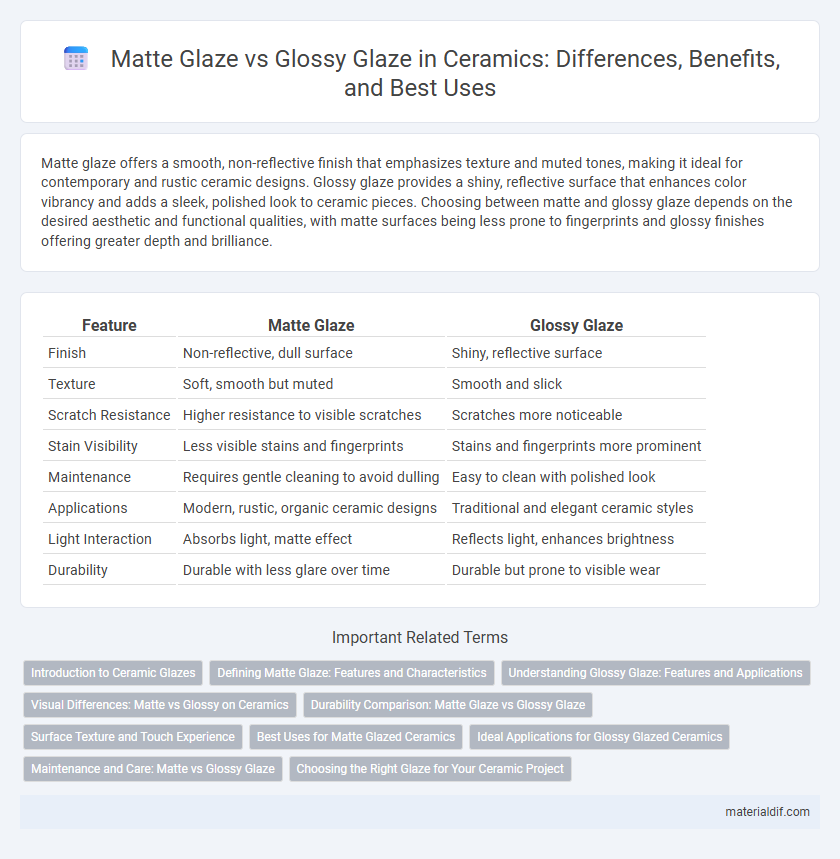Matte glaze offers a smooth, non-reflective finish that emphasizes texture and muted tones, making it ideal for contemporary and rustic ceramic designs. Glossy glaze provides a shiny, reflective surface that enhances color vibrancy and adds a sleek, polished look to ceramic pieces. Choosing between matte and glossy glaze depends on the desired aesthetic and functional qualities, with matte surfaces being less prone to fingerprints and glossy finishes offering greater depth and brilliance.
Table of Comparison
| Feature | Matte Glaze | Glossy Glaze |
|---|---|---|
| Finish | Non-reflective, dull surface | Shiny, reflective surface |
| Texture | Soft, smooth but muted | Smooth and slick |
| Scratch Resistance | Higher resistance to visible scratches | Scratches more noticeable |
| Stain Visibility | Less visible stains and fingerprints | Stains and fingerprints more prominent |
| Maintenance | Requires gentle cleaning to avoid dulling | Easy to clean with polished look |
| Applications | Modern, rustic, organic ceramic designs | Traditional and elegant ceramic styles |
| Light Interaction | Absorbs light, matte effect | Reflects light, enhances brightness |
| Durability | Durable with less glare over time | Durable but prone to visible wear |
Introduction to Ceramic Glazes
Ceramic glazes transform the surface of pottery by adding color, texture, and waterproofing, with matte glaze providing a non-reflective, smooth finish that enhances organic, earthy aesthetics. Glossy glaze offers a shiny, reflective surface that intensifies color vibrancy and highlights intricate details, ideal for decorative pieces. Both glaze types involve different chemical compositions and firing temperatures, influencing durability and visual effect on ceramic ware.
Defining Matte Glaze: Features and Characteristics
Matte glaze offers a non-reflective, muted finish that emphasizes texture and form, providing an earthy and natural aesthetic to ceramic pieces. Its surface is typically soft and smooth but lacks the shiny luster of glossy glaze, making it ideal for rustic or contemporary designs that favor subtlety. Matte glazes often highlight imperfections and brushstrokes, enhancing the handcrafted quality and depth of the ceramic art.
Understanding Glossy Glaze: Features and Applications
Glossy glaze creates a shiny, reflective surface that enhances color vibrancy and highlights intricate ceramic details, making it ideal for decorative pottery and art pieces. Its smooth texture provides a durable, non-porous finish that repels moisture and stains, suitable for functional items like dishware and tiles. The reflective quality of glossy glaze also amplifies light effects, adding visual depth and richness to ceramic surfaces in both contemporary and traditional designs.
Visual Differences: Matte vs Glossy on Ceramics
Matte glaze on ceramics creates a soft, non-reflective surface that emphasizes texture and muted tones, offering a natural, understated aesthetic. Glossy glaze produces a shiny, reflective finish that enhances color vibrancy and surface smoothness, making details more pronounced. The choice between matte and glossy influences the visual impact by affecting light reflection, depth perception, and the tactile appeal of ceramic pieces.
Durability Comparison: Matte Glaze vs Glossy Glaze
Matte glaze offers a more resistant surface to scratches and fingerprints due to its textured finish, enhancing durability in high-traffic ceramic items. Glossy glaze, while visually vibrant and smooth, tends to show wear and minor damage more readily, making it less ideal for heavy use. Choosing between matte and glossy glaze impacts the longevity of ceramic pieces based on their exposure to handling and environmental factors.
Surface Texture and Touch Experience
Matte glaze offers a smooth, non-reflective surface with a subtle, velvety texture that enhances tactile appeal and reduces glare. Glossy glaze features a shiny, reflective finish that feels slick and smooth to the touch, highlighting colors and details with high visual impact. The choice between matte and glossy glaze significantly influences the ceramic piece's aesthetic and sensory experience.
Best Uses for Matte Glazed Ceramics
Matte glazed ceramics excel in contemporary home decor and minimalist design due to their subtle, non-reflective surface that highlights texture and form. They are ideal for functional pottery like dinnerware and planters, providing a tactile grip and a sophisticated, understated aesthetic. Matte finishes also perform well in low-light environments by reducing glare and enhancing color depth.
Ideal Applications for Glossy Glazed Ceramics
Glossy glazed ceramics are ideal for decorative items, dinnerware, and tiles where a shiny, reflective surface enhances color vibrancy and detail. Their smooth, non-porous finish makes them well-suited for items requiring easy cleaning and resistance to stains and moisture. Glossy surfaces also amplify lighting effects, making them popular in both functional and artistic applications in kitchens, bathrooms, and galleries.
Maintenance and Care: Matte vs Glossy Glaze
Matte glaze surfaces resist fingerprints and scratches better than glossy glaze, making them easier to maintain in high-traffic areas. Glossy glaze requires frequent cleaning to preserve its reflective shine but is more stain-resistant due to its smooth, sealed finish. Both finishes benefit from gentle cleaning agents, though acidic or abrasive cleaners can dull or damage matte surfaces more readily.
Choosing the Right Glaze for Your Ceramic Project
Matte glaze offers a smooth, non-reflective finish ideal for a natural, understated aesthetic in ceramic projects, enhancing texture and detail without glare. Glossy glaze creates a shiny, reflective surface that intensifies colors and adds a vibrant, polished look, perfect for decorative or functional pieces requiring a high-impact visual appeal. Selecting the right glaze depends on the desired visual effect, durability needs, and the type of ceramic application, ensuring the finished piece meets both artistic and practical goals.
Matte Glaze vs Glossy Glaze Infographic

 materialdif.com
materialdif.com